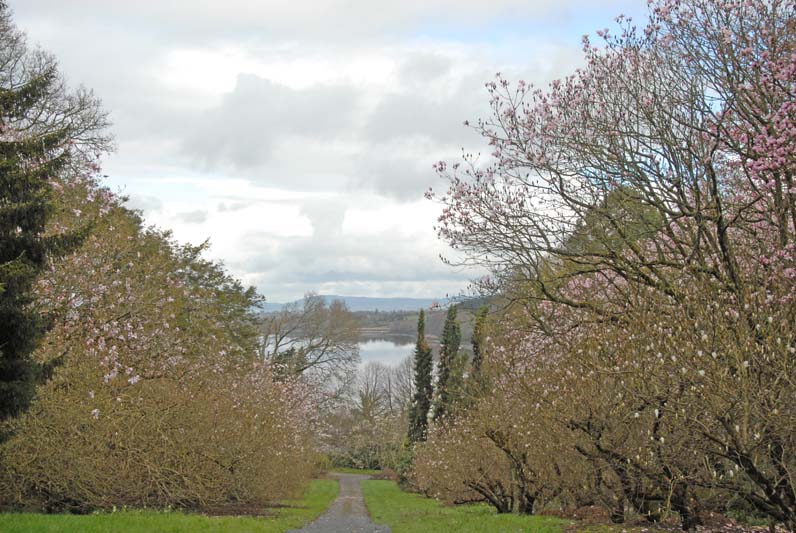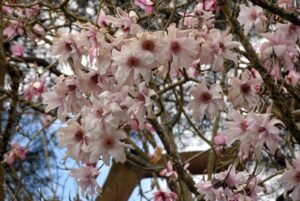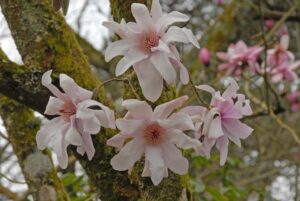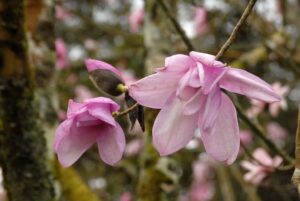Mount Congreve Gardens must be one of the very best places in the world to see magnolias. There are three spectacular plantings of magnolias in the garden: the first and original planting was on the terrace below the house where we can see Magnolia campbellii, Magnolia veitchii and Magnolia sprengeri var diva among others, all now mature and impressive trees. This planting is best viewed from an elevated spot near The Temple where one can look along the top of the canopy of this planting and see magnificent planting one could not encounter anywhere else in the world.

Seed from the specimens of Magnolia campbellii growing in this area were collected and propagated in the early 1960s and later planted on the terraces near the waterfall, an area below The Temple which features an impressive planting of hundreds of hydrangeas in late summer. Approximately 80 seedling Magnolia campbellii seedlings were planted here along with 70+ Rhododendron macabeanum. Mr. Congreve always planted for impact and single specimen trees or plants are rare in the garden – planting was always in big numbers. These are mature trees now, approaching 20 metres in height, and are very impressive.

The Magnolia Walk, a straight walk downhill of approximately 150 metres with a view to the River Suir and beyond to County Kilkenny, is lined on both sides with Magnolia soulangeana backed by the taller Magnolia campbellii and Magnolia sargentiana var. robusta. The grass verges are planted with Frittilaria meleagris, the Snakeshead Frittilary, and Primula veris, the cowslip. To say this planting is impressive is a woefully inadequate description – it is fabulous, fantastic, unprecedented, unique and quite simply extraordinary.


Apart from these mass plantings there are also some especially beautiful individual magnolias in the garden which deserve a visit and closer viewing. Magnolia ‘John Congreve’ is the most accessible and obvious as it stand proudly on the Bell Gate Lawn, the exit from the Pleasure Garden to the Woodland Garden. It is named for Ambrose Congreve’s father and was bought from Hillier’s as Magnolia sargentiana var. robusta but quickly showed itself to be something quite different and distinctive and is regarded as an exceptional form of Magnolia sprengeri var. diva. There was some concern over the last few years for the health of this plant, that the area around the base was becoming compacted and possible damage to roots near the surface because of grass cutting but it is performing fabulously this year and is a sight to behold.


A relatively new planting on the Bell Gate lawn is Magnolia campbellii ‘Betty Jessel’ which was planted only last year to replace an ailing Magnolia sargentiana var. robusta. It is already a four to five metre high tree and is flowering prolifically at present and the blossoms are spectacularly beautiful and show the perfect “cup and saucer” flowers of Magnolia campbellii.

There are two other magnolias bearing the Congreve name in the garden: Magnolia ‘Lady Irene Congreve’ and I presume this refers to Mr. Ambrose Congreve’s mother, Lady Helena Blanche Irene Ponsonby, daughter of Edward Ponsonby, 8th Earl of Bessborough. The other is Magnolia ‘Ambrose Congreve’ the creator of these magnificent gardens at Mount Congreve.



At the lower end of the Magnolia Walk there are two outstanding specimens, both forms of Magnolia sargentiana var. robusta. These have more petals than normal and they are these are held in an open manner which gives a great colour cover to the tree so that each would make a strong impact in the garden. One has flowers which are very lightly coloured while the other is darker. At present, they are unnamed but I feel they certainly deserve to have a name attached. They are, I suppose, indicative of the many, many treasures at Mount Congreve Gardens, a garden which itself is a treasure beyond compare among the gardens of the world. I am very fortunate that it is only minutes from my home and that I am able to visit regularly. You must make time to come and visit also!



Paddy Tobin
To find out more about the Irish Garden Plant Society visit our website or follow us on Facebook
